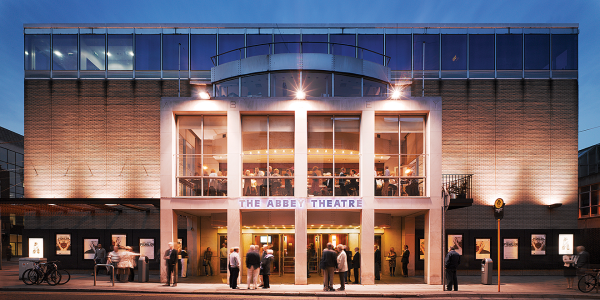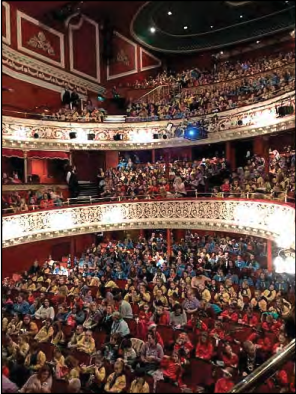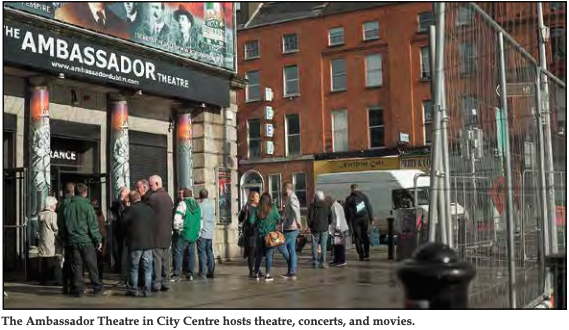September 7, 2023

The Abbey Theatre in Dublin’s North City Centre seats 662
Art is the magic mirror you make to reflect your invisible dreams in visible pictures. You use a glass mirror to see your face: you use works of art to see your soul.
– George Bernard Shaw
This month I am going to steer clear of the major issues of the day: the ever-growing list of Trump indictments that somehow benefit him in the Republican polls, Brexit fallout, climate breakdown, doom loops, and the Ukraine war. Instead, I will share some thoughts on one of the true delights of visiting or living in Dublin: the theater. Discussing “the theater” is a risky business, easily interpreted as conclusive evidence of snobbery, like joining a wine tasting club or using “summer” as a verb. In Ireland, going to the theater is not burdened by the connotation of pretension mostly because live drama is accessible pricewise and people of all walks of life go to a lot of plays.
Live performances, whether a concert, a ball game, or a play are opportunities to share one-time-only experiences with others, to participate in the cultural life of a community and remind us that we are all part of a human family.
 I encourage BostonIrish readers planning a trip to Ireland to have a look at what’s playing at The Abbey, The Gaiety, The Olympia, The Gate, or Smock Alley theaters. You might recognize an old favorite by Samuel Beckett, Flann O’Brien, Arthur Miller, or Sean O’Casey. A familiar contemporary playwright like Martin McDonough, Sebastian Barry, or Sonya Kelly might have a new show. More of a fan than an expert, I usually just take a chance, and we have been delighted almost every time.
I encourage BostonIrish readers planning a trip to Ireland to have a look at what’s playing at The Abbey, The Gaiety, The Olympia, The Gate, or Smock Alley theaters. You might recognize an old favorite by Samuel Beckett, Flann O’Brien, Arthur Miller, or Sean O’Casey. A familiar contemporary playwright like Martin McDonough, Sebastian Barry, or Sonya Kelly might have a new show. More of a fan than an expert, I usually just take a chance, and we have been delighted almost every time.
Why the theater is so robust in Ireland is the source of some debate. Perhaps its origins can be traced to the rich oral history and storytelling tradition practiced by the seanchaithe of ancient Ireland, who preserved the island’s myths and legends. The oldest theater in Dublin is Smock Alley which was built in 1662. During its heyday there were sold out performances for 300 audience members 7 days a week. A turning point for Irish theater was the Gaelic Revival of the late 19th century led by Yeats, Lady Gregory, JM Synge, and others. The mission of the Gaelic Revival was to revitalize and preserve Irish culture: music, dance, sports, language, and literature.
The Abbey Theatre was opened in 1904 as a part of this assertion of Irish cultural nationalism. Catholics of James Joyce’s generation were the first to gain broad access to higher education and were able to add their voices and stories. During this period, the Irish became prolific producers of drama, and the public became omnivorous consumers of quality theater. The good news is that it is still as rich a landscape as ever. The even better news is that the hard-won rights for women in recent times have welcomed many new voices and perspectives.
Shows churn through the city quickly for one or two week runs, so it’s important to keep an eye on what’s playing. In addition to the main halls, there is another layer of smaller venues to discover. Bewley’s Cafe, best known for its tea, scones, and historic stained-glass windows, is located on Grafton Street and has a small upstairs theater. Just a short walk from Bewley’s on Wicklow Street is The International Bar that also has an upstairs theater used for plays, stand-up comedy, and small concerts. In both venues, one-act, 50-minute plays are performed by the writers themselves who also typically serve as the ticket office and ushers for the 20-30 audience members. At the International, you will also have the advantage of enjoying a pint during the play.
The plays invariably have that unique Irish quality of being simultaneously funny and poignant, inspiring laughter and tears in equal measure. A recent favorite was “The Sand Pit,” written and acted by Seamus O’Rourke, who is a mountain of a man and very much the authentic farmer from Leitrim he portrays. It is an intimate journey into rural Ireland: life, death, faith, friendship, family, grief, grievance, loss, loyalty, and love. Seamus has another one-man show, “Mossy Flood,” currently playing in a small theater in Clontarf that I have not seen yet. Always more to discover!
Plays in Dublin will not cost you a king’s ransom. The ticket prices at the main theaters are usually in the 20-25-euro range while the upstairs plays are priced at 10-15 euros. Generous government subsidies for the arts help keep prices affordable, which means that nearly everyone can go and that if you run into something that you don’t like, it’s not the end of the world.
Long-time Dubliners say that the theater has “always been strong” and that the pandemic has not had a lasting negative impact on theater companies. Actor- director-producer Ronan Wilmot, whose roles with the Royal Shakespeare Company and film credits in “The Field” and “In The Name of the Father” make him a fixture in Dublin theater, remarked that the only noticeable change since the pandemic is that theater goers are more likely to give standing ovations these days, perhaps an expression of pent up enthusiasm and the joy of being back in the theater.
The Irish gift for the written word is long established. This year is the 100th anniversary of WB Yeats’s winning of the Nobel Prize for Literature. I attended a free lecture celebrating the anniversary at the National Library and learned that while today we remember Yeats as a poet, his prize was awarded primarily for his plays. His award also represented an invitation to long-isolated and newly independent Ireland to join the world’s intellectual community. Shaw, Beckett, and Heaney have received the award since.
Yeats’s prize was recognition of his individual genius and more broadly of the success of the Gaelic Revival that he championed. It is also linked indirectly to Irish Republicanism. The person who first nominated Yeats for the prize was the father of Joseph Mary Plunkett, who participated in the Easter Rising and was a signatory of the Proclamation. Plunkett, himself a poet, was executed by firing squad in 1916 seven hours after his marriage to Grace Gifford in the chapel of Kilmainham Gaol, a moment immortalized in the song “Grace.”
Irish playwrights have never shied away from controversy. Sean O’Casey’s “Plough and Stars” criticized the rebellion and caused riots when it opened at the Abbey Theatre in 1926. A new play, “O Brother!” takes on the issue of Mother and Baby Homes and forced adoption. Irish adults who were adopted only won the right to research and contact their birth families in 2022, so the subject is current and controversial. The central conceit (a 10-dollar theater-word that means ‘the underlying fictitious assumption which must be accepted by the audience with suspension of disbelief so the plot may be seen as plausible) of the play is that two newly reunited brothers recount their recent discovery of each other. The dialogue is entirely in verse and explores the themes of brotherhood, identity, abandonment, guilt, loss, faith, love, jealousy, and hope. All of it.
“The Last Return” by Sonya Kelly was staged at The Gate in what was once an auditorium of the Rotunda Hospital. It is a hilarious play about the lengths the five characters will go to obtain the last return ticket to a hot play that is a metaphor for how in all of our lives, there are moments when we plead with the universe for a special favor that we desperately need: the college acceptance letter, the dream job, the marriage proposal, the cancer treatment. “The Last Return” dramatizes what happens when those competing needs collide.
Going to one live performance can serendipitously lead to another. I saw a Roger Doyle concert of original compositions inspired by “Finnegan’s Wake” at the James Joyce Center, a restored Georgian townhouse that serves as a museum of Joyce artifacts and as an occasional venue for concerts and plays. My motivation for going was that after several attempts, I cannot make heads or tails of “Finnegan’s Wake.” I thought the concert might give me a clue or two.
After the concert, which left me still completely baffled by the book, I met Ronan Wilmot, who suggested I might like a new play he was directing called “Nora and Jim” that would be at the Joyce Center for two nights only. The one- act play brings to life the relationship between Nora Barnacle and James Joyce from their meeting on Nassau Street, self-imposed exile in Trieste and Paris, to Jim’s death in Zurich. It was mesmerizing. The theatrical culture in Dublin is intellectual but also casual: “Ach, it’s no bother lads, I don’t f$%#@ understand Finnegan’s Wake either.”
Whatever the secret sauce is to have a thriving theater scene, Dublin has most of the elements. Just as Silicon Valley is a hotbed for software and Cambridge/Boston is a center for pharma and biotech research, Dublin is a magnet for actors, playwrights, directors, and producers. Intentional policies to promote this cultural treasure are constantly reviewed. This summer, larger ticket subsidies for young people confined during Covid were funded. This cohort fell out of, or never got into, the habit of theater going. The Dublin City Council has also scheduled events promoting new productions. For those visiting Dublin soon, there is a theater festival planned from Sept. 28 to Oct. 15. (dublintheatrefestival.ie) The biggest challenge for Dublin generally, and her art community specifically, is the lack of affordable housing.

Today’s prosperous, inclusive Ireland, liberated from what Joyce described as “the twin tyrannies” of the British Empire and the orthodoxy of the Catholic Church, might herald the beginning of a theatrical golden age. Many of the past great Irish writers and playwrights were forced to leave the island. Oscar Wilde left for France because homosexuality was illegal in Ireland until the 1990s. Joyce’s “Ulysses” was condemned by the church as pornography, so the Irish government of the time did not even bother to ban it. Unavailable in bookstores; very few Irish people of his generation read it. Brendan Behan, who wrote in Paris and found success in London, once remarked that “the Irish are not my audience, they are my raw material.
The bottom line is that going to the theater in Dublin is fun. You can wear jeans and sneakers and will usually have a friendly chat or two with fellow audience members. As WB Yeats famously observed: “There are no strangers here; only friends you haven’t yet met.”
•••
On a personal note, we traveled to the USA this summer to meet our new grandson, Theo Kirk Hilgart, and his older brother Luka in California. At right, Luka shows his BostonIrish colors.
Recent news out of Dublin
The Notre Dame / Navy Game took place in Dublin’s Aviva Stadium on Aug. 26th. Forty thousand American fans, including many US political leaders, made the pilgrimage to Dublin. Midshipmen and Marines came ashore from the USS Mesa Verde to join the festivities. Dame Street was renamed “Notre Dame Street” for the day and the city center was packed like Paddy’s Day in August.
The event generated at least 150 million euros in tourism trade for Ireland. Boston’s own Jim O’Brien, who sadly passed away earlier this year, would be proud. His vision and energy created the Emerald Isle Classic first played in 1988 when Boston College defeated Army. May Jim’s legacy long endure!

